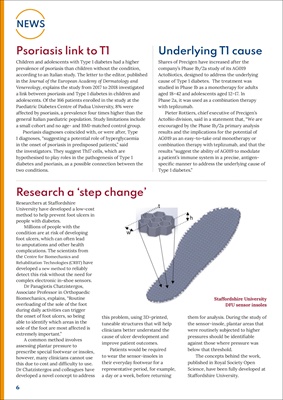
6
NEWS
Research a 'step change'
Psoriasis link to T1
Children and adolescents with Type 1 diabetes had a higher
prevalence of psoriasis than children without the condition,
according to an Italian study. The letter to the editor, published
in the Journal of the European Academy of Dermatology and
Venereology, explains the study from 2017 to 2018 investigated
a link between psoriasis and Type 1 diabetes in children and
adolescents. Of the 166 patients enrolled in the study at the
Paediatric Diabetes Centre of Padua University, 8% were
affected by psoriasis, a prevalence four times higher than the
general Italian paediatric population. Study limitations include
a small cohort and no age- and BMI-matched control group.
Psoriasis diagnoses coincided with, or were after, Type
1 diagnoses, "suggesting a potential role of hyperglycaemia
in the onset of psoriasis in predisposed patients," said
the investigators. They suggest Th17 cells, which are
hypothesised to play roles in the pathogenesis of Type 1
diabetes and psoriasis, as a possible connection between the
two conditions.
Underlying T1 cause
Shares of Precigen have increased after the
company's Phase 1b/2a study of its AG019
ActoBiotics, designed to address the underlying
cause of Type 1 diabetes. The treatment was
studied in Phase 1b as a monotherapy for adults
aged 18-42 and adolescents aged 12-17. In
Phase 2a, it was used as a combination therapy
with teplizumab.
Pieter Rottiers, chief executive of Precigen's
ActoBio division, said in a statement that, "We are
encouraged by the Phase 1b/2a primary analysis
results and the implications for the potential of
AG019 as an easy-to-take oral monotherapy or
combination therapy with teplizumab, and that the
results "suggest the ability of AG019 to modulate
a patient's immune system in a precise, antigenspecific
manner to address the underlying cause of
Type 1 diabetes."
Researchers at Staffordshire
University have developed a low-cost
method to help prevent foot ulcers in
people with diabetes.
Millions of people with the
condition are at risk of developing
foot ulcers, which can often lead
to amputations and other health
complications. The scientists from
the Centre for Biomechanics and
Rehabilitation Technologies (CRBT)
have developed a new method to
reliably detect this risk without the
need for complex electronic inshoe sensors.
Dr Panagiotis Chatzistergos,
Associate Professor in Orthopaedic
Biomechanics, explains, "Routine
overloading of the sole of the foot
during daily activities can trigger
the onset of foot ulcers, so being
able to identify which areas in the
sole of the foot are most affected is
extremely important."
A common method involves
assessing plantar pressure to
prescribe special footwear or insoles,
however, many clinicians cannot use
this due to cost and difficulty to use.
Dr Chatzistergos and colleagues have
developed a novel concept to address
this problem, using 3D-printed,
tuneable structures that will help
clinicians better understand the
cause of ulcer development and
improve patient outcomes.
Patients would be required
to wear the sensor-insoles in
their everyday footwear for a
representative period, for example,
a day or a week, before returning
them for analysis. During the study of
the sensor-insole, plantar areas that
were routinely subjected to higher
pressures should be identifiable
against those where pressure was
below that threshold.
The concepts behind the work,
published in Royal Society Open
Science, have been fully developed at
Staffordshire University.